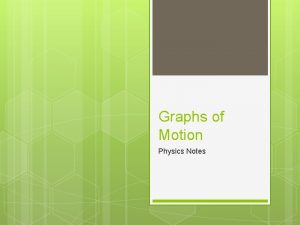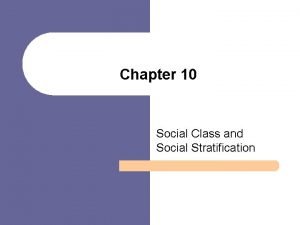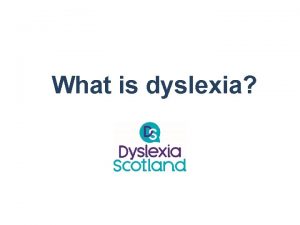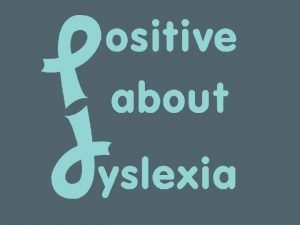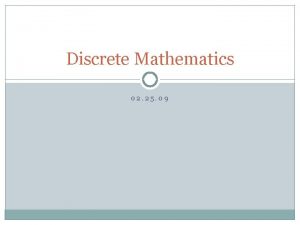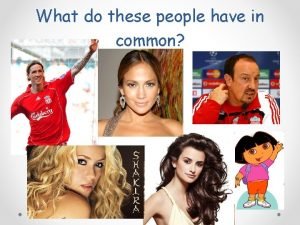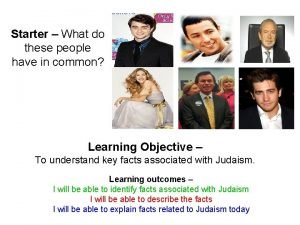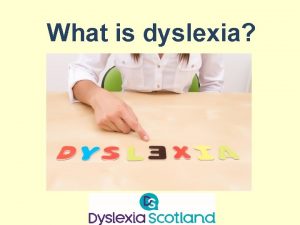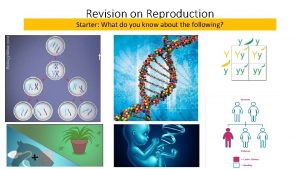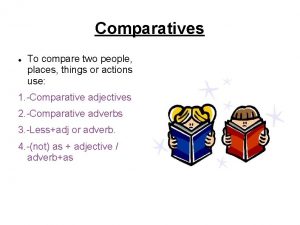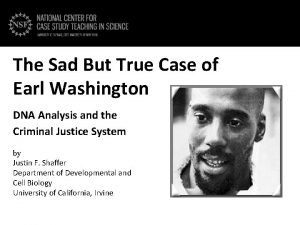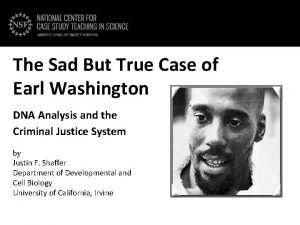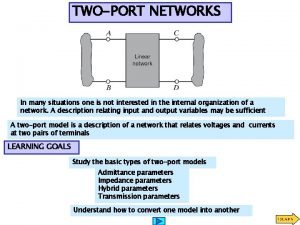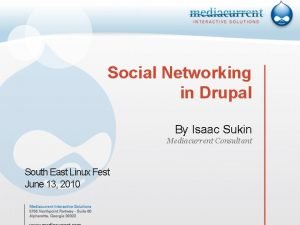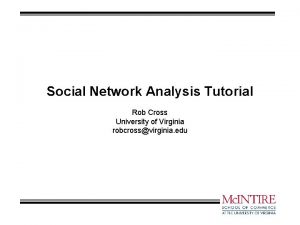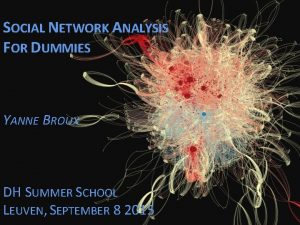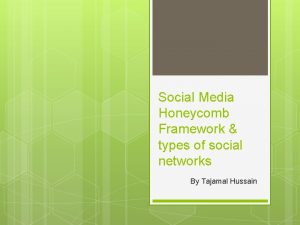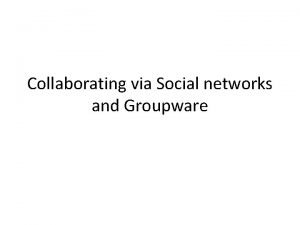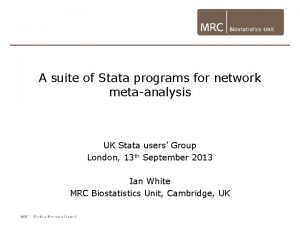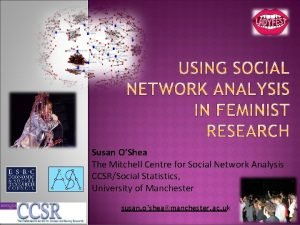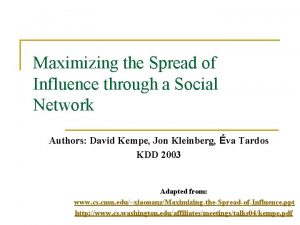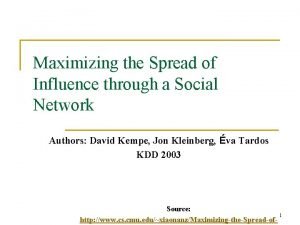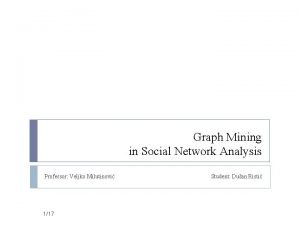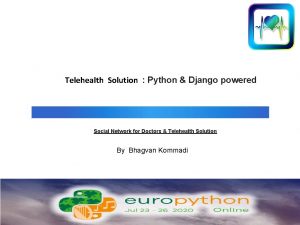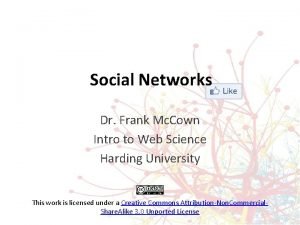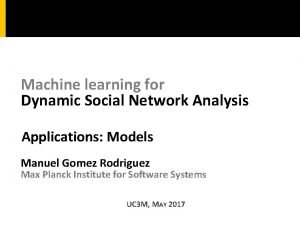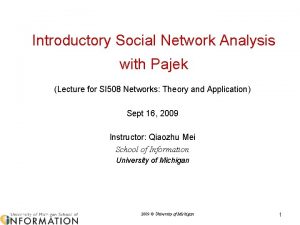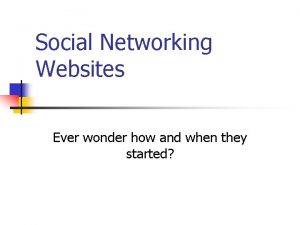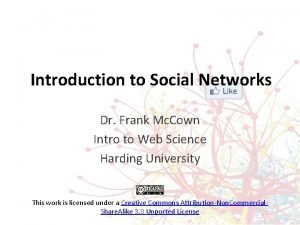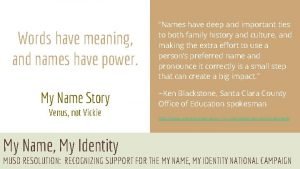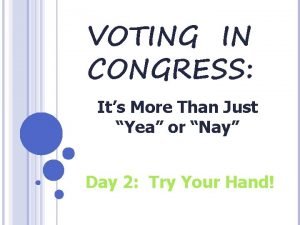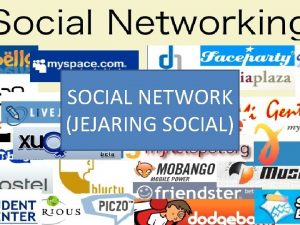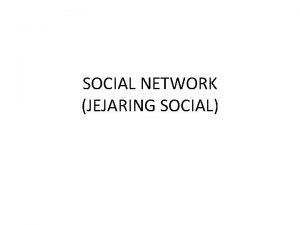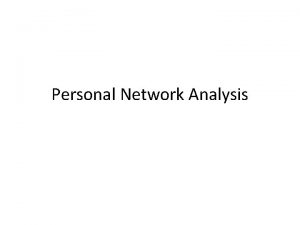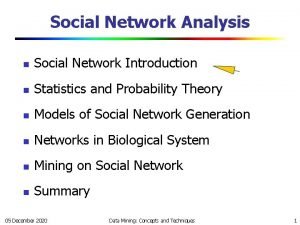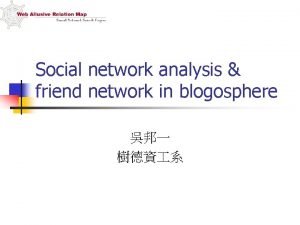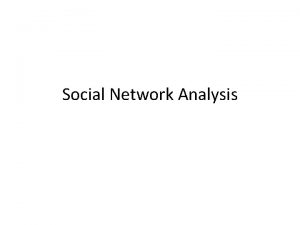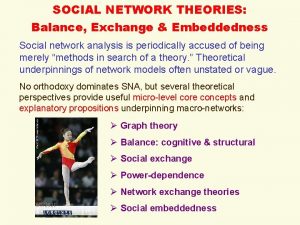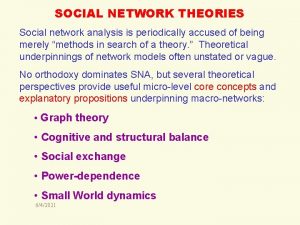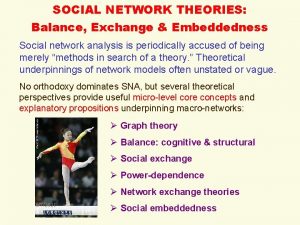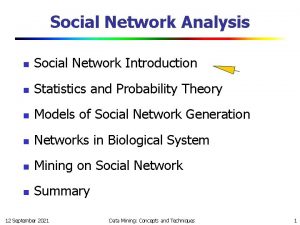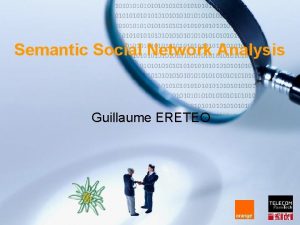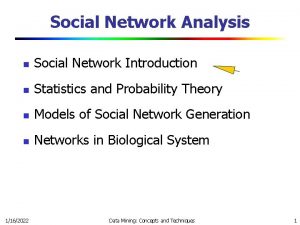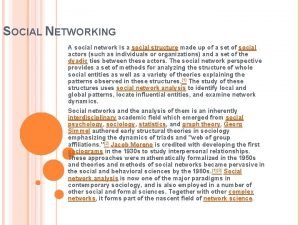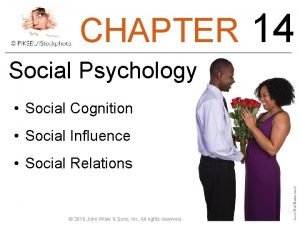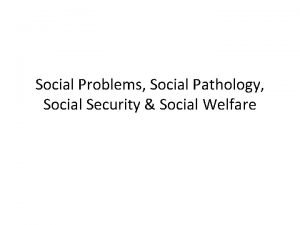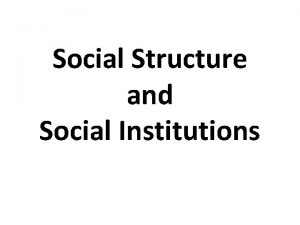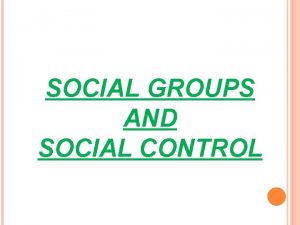If two people in a social network have


































































- Slides: 66

If two people in a social network have a friend in common, then there is an increased likelihood that they will become friends themselves at some point in the future. We refer to this principle as triadic closure, and it is illustrated in the Figure. If nodes B and C have a friend A in common, then the formation of an edge between B and C produces a situation in which all three nodes A, B, and C have edges connecting each other — a structure we refer to as a triangle in the network. http: //www. cs. cornell. edu/home/kleinber/networks-book-ch 03. pdf

Reasons for Triadic Closure One reason why B and C are more likely to become friends, when they have a common friend A, is simply based on the opportunity for B and C to meet: if A spends time with both B and C, then there is an increased chance that they will end up knowing each other and potentially becoming friends. Each of B and C is friends with A (provided they are mutually aware of this) gives them a basis for trusting each other that an arbitrary pair of unconnected people might lack. A third reason is based on the incentive A may have to bring B and C together: if A is friends with B and C, then it becomes a source of latent stress in these relationships if B and C are not friends with each other. Bearman and Moody have found that teenage girls who have a low clustering coefficient in their network of friends are significantly more likely to contemplate suicide than those whose clustering coefficient is high.


(i) We take two snapshots of the network at different times. (ii) For each k, we identify all pairs of nodes who have exactly k friends in common in the first snapshot, but who are not directly connected by an edge. (iii) We define T(k) to be the fraction of these pairs that have formed an edge by the time of the second snapshot. This is our empirical estimate for the probability that a link will form between two people with k friends in common. (iv) We plot T(k) as a function of k to illustrate the effect of common friends on the formation of links. Note that T(0) is the rate at which link formation happens when it does not close a triangle, while the values of T(k) for larger k determine the rate at which link formation happens when it does close a triangle. Thus, the comparison between T(0) and these other values addresses the most basic question about the power of triadic closure.

K&W computed this function T(k) using a dataset encoding the full history of e-mail communication among roughly 22, 000 undergraduate and graduate students over a one-year period at a large U. S. university. Kossinets, G. and D. Watts, ” Empirical analysis of an evolving social network, ” Science, 311: 88 -90, 2006. This is a “who-talks-to-whom” type of dataset, K&W constructed a network that evolved over time, joining two people by a link at a given instant if they had exchanged email in each direction at some point in the past 60 days. The observations in each snapshot were one day apart, so their computation gives the average probability that two people form a link per day, as a function of the number of common friends they have.

The curve turns upward in a particularly pronounced way from 0 to 1 to 2 friends: having two common friends produces significantly more than twice the effect on link formation compared to having a single common friend. (The upward effect from 8 to 9 to 10 friends is also significant, but it occurs on a much smaller subpopulation, since many fewer people in the data have this many friends in common without having already formed a link. )

Suppose that for some small probability p, each common friend that two people have gives them an independent probability p of forming a link each day. So if two people have k friends in common, the probability they fail to form a link on any given day is (1−p)k Since (1 − p)k is the probability the link fails to form on a given day, the probability that it does form, is Tbaseline(k) = 1 − (1 − p)k The point is not to propose this baseline as an explanatory mechanism for triadic closure, but rather to look at how the real data compares to it. Both the real curve and the baseline curve are close to linear, and hence qualitatively similar; but the fact that the real data turns upward while the baseline curve turns slightly downward indicates that the assumption of independent effects from common friends is too simple to be fully supported by the data.

The clustering coefficient of a node A is defined as the probability that two randomly selected friends of A are friends with each other. It is the fraction of pairs of A’s friends that are connected to each other by edges. The clustering coefficient of node A in the Figure is 1/6 (because there is only the single C-D edge among the six pairs of friends B-C, B-D, B-E, C-D, C-E, and D-E).

The Strength of Weak Ties The person labeled A has four friends in this picture, but one of her friendships is qualitatively different from the others: A’s links to C, D, and E connect her to a tightly-knit group of friends who all know each other, while the link to B seems to reach into a different part of the network. We say that an edge joining two nodes A and B in a graph is a bridge if deleting the edge would cause A and B to lie in two different components. In other words, this edge is literally the only route between its endpoints, the nodes A and B.

Four single friends – comic Jerry Seinfeld, bungling George, frustrated working gal Elaine and eccentric neighbor Kramer – deal with the absurdities of everyday life in New York City. https: //www. youtube. com/watch? v=u. PG 3 YMc. Svzo “Worlds Collide Theory” There are two Georges: Independent George and Relationship George. Independent George is the one that spends time with Jerry, Elaine, and Kramer. Relationship George is the one that has to spend time with his girlfriend, Susan. Since Elaine has invited George's girfriend into the circle of friends, George can not get away from his relationship duties and become independent. This ruins the life of Independent George.

Bridges are presumably extremely rare in real social networks

Here, the A-B edge isn’t the only path that connects its two endpoints; though they may not realize it, A and B are also connected by a longer path through F, G, and H. This kind of structure is arguably much more common than a bridge in real social networks.

An edge joining two nodes A and B in a graph is a local bridge if its endpoints A and B have no friends in common. — in other words, if deleting the edge would increase the distance between A and B to a value strictly more than two. The span of a local bridge is the minimum distance its endpoints would be from each other if the edge were deleted. The A-B edge is a local bridge with span four.

Local bridges, especially those with reasonably large span, still play roughly the same role that bridges do, though in a less extreme way — they provide their endpoints with access to parts of the network, and hence sources of information, that they would otherwise be far away from. We might expect that if a node like A is going to get truly new information, the kind that leads to a new job, it might come unusually often (though certainly not always) from a friend connected by a local bridge.

Distinguish between different levels of strength in the links of a social network Stronger links represent “closer” friendship and greater frequency of interaction. Categorize all links in the social network as belonging to one of two types: strong ties (the stronger links, corresponding to friends), and weak ties (the weaker links, corresponding to acquaintances)

Tie Strength on Facebook. http: //overstated. net/2009/03/09/maintained-relationships-on-facebook Where are the strong ties among a user’s friends? A link represents reciprocal (mutual) communication, if the user both sent messages to the friend at the other end of the link, and also received messages from them during the observation period. A link represents one-way communication if the user sent one or more messages to the friend at the other end of the link (whether or not these messages were reciprocated). A link represents a maintained relationship if the user followed information about the friend at the other end of the link, whether or not actual communication took place. “following information” here means either clicking on content via Facebook’s News Feed service (providing information about the friend) or visiting the friend’s profile more than once.

the network neighborhood of a sample Facebook user — consisting of all his friends, and all links among his friends. http: //overstated. net/2009/03/09/maintained-relationships-on-facebook

Adjacency Matrix undirected networks

Moreover, as we restrict to stronger ties, certain parts of the network neighborhood thin out much faster than others. We see two distinct regions where there has been a particularly large amount of triadic closure: one in the upper part of the drawing, and one on the right-hand side of the drawing. However, when we restrict to links representing communication or a maintained relationship, we see that a lot of the links in the upper region survive, while many fewer of the links in the right-hand region do. The right-hand region may represent a set of friends from some earlier phase of the user’s life, but do not actively remain in contact; the upper region, on the other hand, consists of more recent friends for whom there is more frequent contact.

Users who report very large numbers of friends on their profile pages (on the order of 500), the number with whom they actually communicate is generally between 10 and 20, and the number they follow even passively (e. g. by reading about them) is under 50. passive engagement, in which one keeps up with friends by reading news about them even in the absence of communication. passive network occupies an interesting middle ground between the strongest ties maintained by regular communication and the weakest ties (from one’s distant past).

Tie Strength on Twitter http: //firstmonday. org/article/view/2317/2063 Twitter also includes social-network features, and distinguish between stronger and weaker ties: each user can specify a set of other users whose messages he or she will follow, and each user can also direct messages specifically to another user. Specifically, for each user the authors considered the number of users whose messages she followed (her “followees”), and then defined her strong ties to consist of the users to whom she had directed at least two messages over the course of an observation period. Huberman, Romero, and Wu, “Social networks that matter: Twitter under the microscope, ” First Monday, 14(1), January 2009.

http: //firstmonday. org/article/view/2317/2063

By definition, each strong tie requires the continuous investment of time and effort to maintain, and so even people who devote a lot of their energy to building strong ties will eventually reach a limit — imposed simply by the hours available in a day — on the number of ties that they can maintain in this way. The formation of weak ties is governed by much milder constraints — they need to be established at their outset but not necessarily maintained continuously — and so it is easier for someone to accumulate them in large numbers. So what?

If a node A has edges to nodes B and C, then the B-C edge is especially likely to form if A’s edges to B and C are both strong ties.

We say that a node A violates the Strong Triadic Closure Property if it has strong ties to two other nodes B and C, and there is no edge at all (either a strong or weak tie) between B and C. We say that a node A satisfies the Strong Triadic Closure Property if it does not violate it.

s Let us check that is any node in the Figure violates the Strong Triadic Closure Property, and hence all nodes satisfy the Property. If the A-F edge were to be a strong tie rather than a weak tie, what are the nodes that violate Strong Triadic Closure Property?

Let us define the following ratio: (and call neighborhood overlap) number of nodes who are neighbors of both A and B (embeddedness) ________________________ number of nodes who are neighbors of at least one of A or B Consider the edge A – F Numerator: C Denominator: B, C, D, E, G, J (Only C is a neighbor of both A and F) (since these are the ones that are a neighbor of at least one of A or F. ) In the denominator we do NOT count A or F themselves – even though A is a neighbor of F and F is a neighbor of A

The key feature of the neighborhood overlap is that it is 0 precisely when the numerator is 0, and hence when the edge is a local bridge. So the notion of a local bridge is contained within this definition — local bridges are the edges of neighborhood overlap 0 (also embeddedness is 0) — and hence we can think of edges with very small neighborhood overlap as being “almost” local bridges.

We, therefore, view the A – F edge as much closer to being a local bridge than the A – E edge is.

Let us focuse on the contrast between the experience of a node such as A, who sits at the center of a single tightly-knit group, and node B, who sits at the interface between several groups.

What stands out about A is the way in which all of his edges have significant embeddedness. A long line of research in sociology has argued that if two individuals are connected by an embedded edge, then this makes it easier for them to trust one another, and to have confidence in the integrity of the transactions (social, economic, or otherwise) that take place between them. Indeed, the presence of mutual friends puts the interactions between two people “on display” in a social sense, even when they are carried out in private; in the event of misbehavior by one of the two parties to the interaction, there is the potential for social sanctions and reputational consequences from their mutual friends. “My mortification at cheating a friend of long standing may be substantial even when undiscovered. It may increase when a friend becomes aware of it. But it may become even more unbearable when our mutual friends uncover the deceit and tell one another”

No similar kind of deterring threat exists for edges with zero embeddedness, since there is no one who knows both people involved in the interaction. In this respect, the interactions that B has with C and D are much “riskier” than the embedded interactions that A experiences. Moreover, the constraints on B’s behavior are made complicated by the fact that she is subject to potentially contradictory norms and expectations from the different groups she associates with.

Imagining the network under consideration to represent the interaction and collaboration among managers in a large company. In a different language, node B, with her multiple local bridges, spans a structural hole in the organization — the “empty space” in the network between two sets of nodes that do not otherwise interact closely. (Despite the term “local bridge, ” which has a precise mathematical definition in terms of the underlying graph, we give “structural hole” a chance in this discussion. )

Network positions such as node B’s, at the ends of multiple local bridges, confer a distinct set of equally fundamental advantages. B has early access to information originating in multiple, non-interacting parts of the network. Any one person has a limited amount of energy they can invest in maintaining contacts across the organization, and B is investing her energy efficiently by reaching out to different groups rather than basing all her contacts in the same group. A second, related kind of advantage is based on the way in which standing at one end of a local bridge can be an amplifier for creativity. Innovations often arise from the unexpected synthesis of multiple ideas, each of them on their own perhaps well-known, but well-known in distinct and unrelated bodies of expertise.

B’s position in the network provides an opportunity for a kind of social “gatekeeping” — she regulates the access of both C and D to the tightly-knit group she belongs to. She controls the ways in which her own group learns about information coming from C’s and D’s groups. This provides B with a source of power in the organization. Certain people in this situation might try to prevent triangles from forming around the local bridges they’re part of — for example, another edge from C or D into B’s group would reduce B’s gatekeeping role.

Recapiculate the trade-offs in the relative positions of A and B.

Social capital stands for the ability of actors to secure benefits by virtue of membership in social networks or other social structures

Affiliation Focus on how to represent the set of activities a person takes part in, and how these affect the formation of links. http: //www. cs. cornell. edu/home/kleinber/networks-book-ch 04. pdf

Surrounding contexts have been viewed, appropriately, as existing “outside” the network It’s possible to put these contexts into the network itself, by working with a larger network that contains both people and contexts as nodes. Being part of a particular company, organization, or neighborhood; frequenting a particular place; pursuing a particular hobby or interest — these are all activities that, when shared between two people, tend to increase the likelihood that they will interact and hence form a link in the social network

“Focal points” of social interaction — constituting social, psychological, legal, or physical entities around which joint activities are organized Anna participates in both of the foci, while Daniel participates in only one.

We will refer to such a graph as an affiliation network, since it represents the affiliation of people (drawn on the left) with foci (drawn on the right)

composition of boards of directors of major corporations there is a node for each person and a node for each board, and each edge connects a person to a board that they belong to. Boards of directors are relatively small advisory groups populated by high-status individuals Two companies are implicitly linked by having the same person sit on both their boards; we can thus learn about possible conduits for information and influence to flow between different companies. Two people, on the other hand, are implicitly linked by serving together on a board; so we learn about particular patterns of social interaction among some of the most powerful members of society.

Generally, affiliation networks are examples of a class of graphs called bipartite graphs. We say that a graph is bipartite if its nodes can be divided into two sets in such a way that every edge connects a node in one set to a node in the other. (In other words, there are no edges joining a pair of nodes that belong to the same set; all edges go between the two sets. )

The first kind of edge functions as an edge in a social network: it connects two people, and indicates friendship The second kind of edge functions as an edge in an affiliation network: it connects a person to a focus, and indicates the participation of the person in the focus.

It’s clear that both social networks and affiliation networks change over time: new friendship links are formed, and people become associated with new foci. Moreover, these changes represent a kind of coevolution that reflects the interplay between selection and social influence: if two people participate in a shared focus, this provides them with an opportunity to become friends; and if two people are friends, they can influence each other’s choice of foci.

If A, B, and C each represent a person, then the formation of the link between B and C is triadic closure

If B and C represent people, but A represents a focus, it is the tendency of two people to form a link when they have a focus in common, forming links to others who share characteristics with you.

If A and B are people, and C is a focus, then B takes part in a focus that her friend A is already involved in, kind of social influence, in which B’s behavior comes into closer alignment with that of her friend A.

A range of different mechanisms for link formation can all be viewed as types of closure processes, in that they involve “closing” the third edge of a triangle in the network. If A, B, and C each represent a person, then the formation of the link between B and C is triadic closure If A and B are people, and C is a focus, then B takes part in a focus that her friend A is already involved in, kind of social influence, in which B’s behavior comes into closer alignment with that of her friend A. If B and C represent people, but A represents a focus, it is the tendency of two people to form a link when they have a focus in common, forming links to others who share characteristics with you.


Bob introduces Anna to Claire. Karate introduces Anna to Daniel. Anna introduces Bob to Karate. What else?


How much more likely is an edge to form between two people if they have multiple friends in common? In the Figure, Anna and Esther have two friends in common, while Claire and Daniel only have one friend in common.

(i) We take two snapshots of the network at different times. (ii) For each k, we identify all pairs of nodes who have exactly k friends in common in the first snapshot, but who are not directly connected by an edge. (iii) We define T(k) to be the fraction of these pairs that have formed an edge by the time of the second snapshot. This is our empirical estimate for the probability that a link will form between two people with k friends in common. (iv) We plot T(k) as a function of k to illustrate the effect of common friends on the formation of links. Note that T(0) is the rate at which link formation happens when it does not close a triangle, while the values of T(k) for larger k determine the rate at which link formation happens when it does close a triangle. Thus, the comparison between T(0) and these other values addresses the most basic question about the power of triadic closure.

K&W computed this function T(k) using a dataset encoding the full history of e-mail communication among roughly 22, 000 undergraduate and graduate students over a one-year period at a large U. S. university. Kossinets, G. and D. Watts, ” Empirical analysis of an evolving social network, ” Science, 311: 88 -90, 2006. This is a “who-talks-to-whom” type of dataset, K&W constructed a network that evolved over time, joining two people by a link at a given instant if they had exchanged email in each direction at some point in the past 60 days. The observations in each snapshot were one day apart, so their computation gives the average probability that two people form a link per day, as a function of the number of common friends they have.

The curve turns upward in a particularly pronounced way from 0 to 1 to 2 friends: having two common friends produces significantly more than twice the effect on link formation compared to having a single common friend. (The upward effect from 8 to 9 to 10 friends is also significant, but it occurs on a much smaller subpopulation, since many fewer people in the data have this many friends in common without having already formed a link. )

Suppose that for some small probability p, each common friend that two people have gives them an independent probability p of forming a link each day. So if two people have k friends in common, the probability they fail to form a link on any given day is (1−p)k Since (1 − p)k is the probability the link fails to form on a given day, the probability that it does form, is Tbaseline(k) = 1 − (1 − p)k The point is not to propose this baseline as an explanatory mechanism for triadic closure, but rather to look at how the real data compares to it. Both the real curve and the baseline curve are close to linear, and hence qualitatively similar; but the fact that the real data turns upward while the baseline curve turns slightly downward indicates that the assumption of independent effects from common friends is too simple to be fully supported by the data.

Focal closure: what is the probability that two people form a link as a function of the number of foci they are jointly affiliated with? Membership closure: what is the probability that a person becomes involved with a particular focus as a function of the number of friends who are already involved in it? For focal closure, K&W supplemented their university e-mail dataset with information about the class schedules for each student. In this way, each class became a focus, and two students shared a focus if they had taken a class together. They could then compute the probability of focal closure by direct analogy with their computation for triadic closure, determining the probability of link formation per day as a function of the number of shared foci.

A single shared class turns out to have roughly the same absolute effect on link formation as a single shared friend, but after this the curve for focal closure behaves quite differently from the curve for triadic closure: it turns downward and appears to approximately level off, rather than turning slightly upward. Thus, subsequent shared classes after the first produce a “diminishing returns” effect. The real data turns downward more significantly than this independent model. Again, it is an interesting open question to understand how this effect generalizes to other types of shared foci, and to other domains.

Figure is about the blogging site Live. Journal, where friendships are designated by users in their profiles, and where foci correspond to membership in user-defined communities; thus the plot shows the probability of joining a community as a function of the number of friends who have already done so.

The social-affiliation network contains a node for each Wikipedia editor who maintains a user account and user talk page on the system; and there is an edge joining two such editors if they have communicated, with one editor writing on the user talk page of the other. Each Wikipedia article defines a focus — an editor is associated with a focus corresponding to a particular article if he or she has edited the article. Thus, the plot in the Figure shows the probability a person edits a Wikipedia article as a function of the number of prior editors with whom he or she has communicated.

Generalizing the Notions of Weak Ties and Local Bridges An edge is either a strong tie or a weak tie, and it is either a local bridge or it is not. We can make the strength of an edge a numerical quantity, defining it to be, for instance, the total number of minutes spent on phone calls between the two ends of the edge.

The nodes correspond to cell-phone users, and there is an edge joining two nodes if they made phone calls to each other in both directions over an 18 -week observation period. The cell phones in this population may be generally used for personal communication rather than business purposes. The lack of a central directory means that cell-phone numbers are generally exchanged among people who already know each other.

The authors first deleted edges from the network one at a time, starting with the strongest ties and working downward in order of tie strength. The giant component shrank steadily as they did this, its size going down gradually due to the elimination of connections among the nodes. They then tried the same thing, but starting from the weakest ties and working upward in order of tie strength. In this case, they found that the giant component shrank more rapidly, and moreover that its remnants broke apart abruptly once a critical number of weak ties had been removed.

The arguments connecting tie strength with structural properties of the underlying social network make intriguing theoretical predictions about the organization of social networks in real life.

The neighborhood overlap of edges as a function of their percentile in the sorted order of all edges by tie strength. Thus, as we go to the right on the axis, we get edges of greater and greater strength, and because the curve rises in a strikingly linear fashion, we also get edges of greater and greater neighborhood overlap.
 Csi handwriting analysis
Csi handwriting analysis 6 faces 6 vertices
6 faces 6 vertices When two curves coincide the two objects have the same
When two curves coincide the two objects have the same Types social stratification
Types social stratification Apa itu social thinking
Apa itu social thinking Social thinking social influence social relations
Social thinking social influence social relations Different dimensions of people media
Different dimensions of people media People kill and people dyin
People kill and people dyin Transformed people transform people
Transformed people transform people People just people
People just people Difference between virtual circuit and datagram network
Difference between virtual circuit and datagram network Network topologies
Network topologies Features of peer to peer network and client server network
Features of peer to peer network and client server network Ece 526
Ece 526 Network centric computing
Network centric computing Packet
Packet What is dyslexia
What is dyslexia How many people have dislexia
How many people have dislexia Irish head size
Irish head size Have you ever watched people
Have you ever watched people How many different three-letter initials can people have?
How many different three-letter initials can people have? People have different beliefs
People have different beliefs What do these people have in common?
What do these people have in common? Category of life and duties and responsibilities
Category of life and duties and responsibilities Regrettably these days lots of people don't have jobs
Regrettably these days lots of people don't have jobs Where have all the young people gone
Where have all the young people gone What do these people have in common?
What do these people have in common? People have wondered for centuries
People have wondered for centuries Being dyslexic
Being dyslexic Am i asexual
Am i asexual People have always polluted
People have always polluted Have you ever wondered why some people
Have you ever wondered why some people Many _____ people have settled in this megalopolis.
Many _____ people have settled in this megalopolis. Andreas vesalius
Andreas vesalius Comparing 2 people
Comparing 2 people What things make us special
What things make us special A single str may differ between two unrelated people by
A single str may differ between two unrelated people by A single str may differ between two unrelated people by
A single str may differ between two unrelated people by Which flower is included in suit romeo
Which flower is included in suit romeo Pert formula
Pert formula Two layer network
Two layer network Two port network definition
Two port network definition Two ports containing no sources then
Two ports containing no sources then Socialnetworksoftware
Socialnetworksoftware Drupal social network
Drupal social network Rob cross network analysis
Rob cross network analysis Social network analysis for dummies
Social network analysis for dummies Advantages and disadvantages of social network
Advantages and disadvantages of social network My face social media
My face social media Social networks and groupware in cloud computing
Social networks and groupware in cloud computing Network meta-analysis stata
Network meta-analysis stata Dr susan o shea
Dr susan o shea Android social network integration
Android social network integration Maximizing the spread of influence through a social network
Maximizing the spread of influence through a social network Maximizing the spread of influence through a social network
Maximizing the spread of influence through a social network Mining social network graphs
Mining social network graphs Django social network
Django social network Frank social network
Frank social network Machine learning social network analysis
Machine learning social network analysis Enterprise social network
Enterprise social network What is pajek
What is pajek Youtubenn
Youtubenn Frank social network
Frank social network Words have meaning and names have power
Words have meaning and names have power Bill a no mail on saturdays worksheet answers
Bill a no mail on saturdays worksheet answers Modal verbs suggestion
Modal verbs suggestion It is not you they have rejected but me
It is not you they have rejected but me


